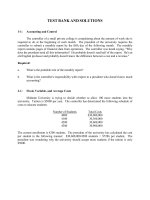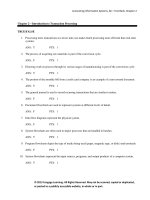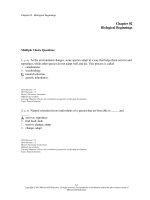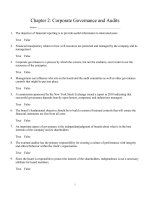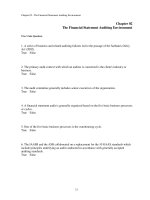Retail management 8th edition levy test bank
Bạn đang xem bản rút gọn của tài liệu. Xem và tải ngay bản đầy đủ của tài liệu tại đây (176.63 KB, 64 trang )
Chapter 02 - Types of Retailers
Chapter 02
Types of Retailers
True / False Questions
1. Prescription pharmaceuticals account for over half or more of drugstores annual sales.
True False
2. Walmart is classified as an off-price retailer.
True False
3. Supermarkets gain higher profit margins from private-label merchandise than national
brands.
True False
4. Hispanics have significantly different shopping and eating patterns from those of the
general population in the United States.
True False
5. Subway is a franchise.
True False
6. The biggest difference between services and merchandise retailers is their profits.
True False
7. Discount stores offer both hard and soft goods for sale.
True False
2-1
Chapter 02 - Types of Retailers
8. Extreme-value retailers have a broad variety but shallow assortment of products offered at
very low prices.
True False
9. An advantage of a large retail chain is that it can respond quickly to market changes and
customer needs.
True False
10. To be competitive in today's marketplace, Supermarkets are focusing on offering
perishable products and meal solutions.
True False
Multiple Choice Questions
11. New retail formats are created and evolve because ______________.
A. consumers lose interest
B. large retailers have undertaken stronger marketing campaigns
C. consumers needs and competition change
D. private branding dictates new fashion
E. retailers have built better relationships with key customers
12. The North American Industry Classification System (NAICS):
A. was developed by the Federal Trade Commission (FTC)
B. uses an 8-digit classification system
C. was created to collect data on North America's business activity
D. is limited in its use to only retail institutions
E. is used only by the United States
2-2
Chapter 02 - Types of Retailers
13. Which of the following statements about NAICS codes is TRUE?
A. The letters in NAICS stand for National Assortments in Commercial Stores.
B. Retailers with the same NAICS codes are likely to compete against each other.
C. A retailer's principal competitor is seldom, if ever, in the same NAICS category.
D. The NAICS code categorizes businesses according to an 8-digit classification system.
E. The classifications for retail firms are based upon the location of the store fronts.
14. _________ refers to the number of different merchandise categories a retailer offers.
A. Inventory mixture
B. Product measurement
C. Product depth
D. Variety
E. Assortment
15. Because the only merchandise categories at the University Futon Shop are double-sized
futons, the Futon Shop can be said to have no ______________.
A. inventory control
B. need for customer service
C. variety
D. shrinkage
E. product depth
16. Each different item of merchandise in a retail store is called a(n) _____________.
A. consumer offering
B. store counted item (SCI)
C. stored and keyed unit (SKU)
D. stock keeping unit (SKU)
E. economic unit
2-3
Chapter 02 - Types of Retailers
17. What does the acronym SKU stand for?
A. Style Kept Utility
B. Stock Keeping Unit
C. Selling Keyboard Utility
D. Stored and keyed Unit
E. None of the above
18. What is the word used to describe a retailer's merchandise "breadth"?
A. Apparition
B. Assortment
C. Modicum
D. Variety
E. Product
19. What is the word used to describe a retailer's merchandise "depth"?
A. Apparition
B. Assortment
C. Modicum
D. Variety
E. Product
20. Variety is often referred to as the _____________.
A. store's supply standard
B. complete retail offering
C. retail mix
D. breadth of merchandise
E. depth of merchandise
21. Assortment is often referred to as the ____________.
A. breadth of merchandise
B. complete retail offering
C. depth of merchandise
D. object of the buy
E. retail mix
2-4
Chapter 02 - Types of Retailers
22. The Men's Wearhouse stocks over 350 different styles and colors of ties. This assortment
of ties can be referred to as the store's _________.
A. supply standard
B. complete retail offering
C. breadth of merchandise
D. retailer mix
E. depth of merchandise
23. Office Depot offers customers a huge selection of office supply merchandise. As a result,
inventory investment _____________.
A. increases because they have to carry back up stock for each SKU
B. increases because of the increase in demand
C. increases because of the value of the assortment
D. decreases because of the increase of the customer base
E. decreases because of the introduction of back up stock
24. Which of the following is NOT TRUE in describing retailers who offer a deep, and broad
assortment?
A. It increases inventory holding costs
B. It increases inventory investment because a retailer must have backup stock for each SKU
C. Discounters and warehouse clubs offer a greater assortment
D. Specialty retailers offer the depth of merchandise
25. Stocking a deep and broad assortment is appealing to customers, but costly for retailers.
What option does a small specialty store owner have to offset costs, and make a profit?
A. charge higher prices
B. hire less staff
C. offer less expensive assortments
D. offer less hours of operation
E. substitute services for merchandise
2-5
Chapter 02 - Types of Retailers
26. How can supermarkets differentiate themselves from other food retailing formats?
A. emphasize fresh perishables
B. target health conscious and ethnic consumers
C. provide a better value with private-label merchandise
D. provide a better shopping experience
E. all of these
27. Whereas conventional supermarkets carry about 30,000 SKUs, limited assortment
supermarkets or extreme value food retailers only stock 2000 SKUs. Which of the following
is NOT the advantage of stocking lesser SKUs?
A. Less inventory holding costs
B. Less backup stocks
C. Less inventory investments
D. More inventory turnover
E. Lower transportation costs
28. The outer walls of a supermarket that stocks fresh merchandise such as dairy, bakery,
meat, produce, etc. is referred to as the ________.
A. power perimeter
B. fresh track
C. profit border
D. edge force
E. essential edge
29. Building on their strength, supermarkets are offering fresh meal solutions for
_________________ consumers.
A. low-income
B. time-pressured
C. ethnic
D. vegetarian
2-6
Chapter 02 - Types of Retailers
30. The _____________ focuses on reducing the carbon footprint caused by the transportation
of food throughout the world.
A. core insight plan
B. locavore movement
C. fair labor standards
D. reversed profits guidelines
E. fair trade policy
31. Purchasing from factories that pay workers a living wage (more than the minimum wage)
and offer other benefits to the employees is called __________.
A. core insight
B. locavore
C. fair labor
D. reversed profits
E. fair trade
32. What is the challenge big box stores face, while developing locations in Europe and
Japan?
A. limited and expensive land
B. increased operating costs
C. restricted building size in some counties
D. opposing sentiments from local residents
E. all of these
33. Warehouse clubs:
A. have extensive assortments
B. expensive store designs and aesthetics
C. high inventory holding costs
D. sell merchandise in a no-frills atmosphere
E. provide extensive customer service
2-7
Chapter 02 - Types of Retailers
34. Which of the following statements about warehouse clubs is TRUE?
A. Warehouse clubs only sell to ultimate consumers.
B. Warehouse clubs have a category specialist format.
C. Warehouse clubs typically have low inventory holding costs.
D. Warehouse clubs have extensive merchandise depth.
35. Angelo manages a local convenience store that sells gasoline. When gas prices are high,
his sales increase, but gas margins are low. So, depending upon gas sales for the success of
the business can be a problem for him. What should Angelo do?
A. add fresh healthy food and new convenient services to the product mix
B. open more gas pumps
C. temporarily lower gas prices to motivate customers to fill up at his store
D. sell two-for-one candy with every fill-up
E. all of the above
36. Which of the following is the biggest threat to convenience stores?
A. Increasing prices on convenience foods
B. Supermarket chains also offering gasoline
C. Vending machines
D. Consumers having more expendable time to shop and compare prices
E. Off-price retailers
37. Why do category specialists call themselves "category killers"?
A. Because they have a lock on the competition, they can demand higher prices.
B. By offering a complete assortment in a category at low prices, category specialists can
"kill" a category of merchandise for other retailers.
C. To keep costs low, employee assistance is nonexistent, thus has "killed" off customer
service.
D. As they edit their product assortments, they narrow down and drop off classifications.
2-8
Chapter 02 - Types of Retailers
38. A retailer that carries a broad variety and deep assortment, offers customer services, and is
organized into separate departments for displaying merchandise is called a __.
A. off-price retailer
B. department store
C. discount retailer
D. convenience store
E. specialty retailer
39. _________________ offer an inconsistent assortment of brand-name, fashion-oriented
soft goods at low prices.
A. Off-price retailers
B. Department stores
C. Discount retailers
D. Convenience stores
E. Specialty retailers
40. What type of store is Kohl's considered?
A. Off-price retailer
B. Department store
C. Full-line discount store
D. Extreme value retailer
E. Specialty retailer
41. What type of store is Target considered?
A. Off-price retailer
B. Department store
C. Full-line discount store
D. Extreme value retailer
E. Specialty retailer
2-9
Chapter 02 - Types of Retailers
42. What type of store is Dollar-General considered to be?
A. Off-price retailer
B. Department store
C. Full-line discount store
D. Extreme-value retailer
E. Specialty retailer
43. What type of store is T.J. Maxx considered to be?
A. Off-price retailer
B. Department store
C. Full-line discount store
D. Extreme-value retailer
E. Specialty retailer
44. Which of the following is a first tier department store?
A. Macy's
B. Nordstrom
C. Sears
D. Kohl's
E. JCPenney
45. Which of the following is a second tier department store?
A. Macy's
B. Neiman Marcus
C. TJ Maxx
D. Nordstrom
E. None of these
46. Which of the following is a third tier department store?
A. Macy's
B. Neiman Marcus
C. TJ Maxx
D. Nordstrom
E. None of these
2-10
Chapter 02 - Types of Retailers
47. What can department stores do to differentiate their merchandise offering AND strengthen
their image?
A. Increase their pricing
B. Network with a broader variety of vendors
C. Seek exclusive arrangements with nationally recognized brands
D. Merge with faltering retailers to gain their market share
E. Keep assortments in line with European styles and fads
48. Attempting to combat losing market share, department stores are ____________.
A. becoming more effective with multichannel retailing
B. adding exclusive merchandise to their assortments
C. developing stronger marketing campaigns to enhance their store image
D. all of these
49. Department stores have placed an emphasis on their own private branded merchandise to
_______________.
A. attract the attention of the junior market
B. differentiate their product offerings
C. keep price points lower
D. reduce the number of markdowns at the end of a season
E. sever relationships with low profit vendors
50. To respond to a competitive discount environment, Walmart is fighting back by __.
A. opening supercenters while closing full-line discount stores
B. focusing on promotional temporary sales
C. increasing assortments
D. offering better customer service on the floor
E. reducing prices below wholesale
2-11
Chapter 02 - Types of Retailers
51. Which of the following statements about full-line discount stores is TRUE?
A. They do not carry private-label merchandise.
B. They have a narrow breadth of merchandise.
C. They typically carry more brands and sizes in each category than department stores.
D. They have inconsistent assortments.
E. None of the above statements about full-line discount stores are true.
52. Specialty stores that focus on specific market segments are vulnerable to _____.
A. shifts in customer tastes and preferences
B. high price points
C. operating parameters set by mall management
D. strong competition from the department stores that sell comparable merchandise
E. overstocking
53. Why are category specialists sometimes called category killers?
A. because they are often located in dying shopping malls
B. because they are located at stand-alone sites
C. because of their broad merchandise mix and shallow assortment
D. because they can dominate a category of merchandise making it difficult for other retailers
to compete
E. because they carry mainly technologically obsolete merchandise
54. Best Buy is a category specialist for the electronics industry.
This means the stores ___________.
A. offer their customers narrow breadth and depth
B. use quick-response inventory management systems
C. have excellent after-the-sale service
D. appeal to the mature consumers
E. offer a narrow but deep assortment of merchandise
2-12
Chapter 02 - Types of Retailers
55. Off-price retailers ________.
A. offer a consistent assortment of soft goods at low prices
B. sell brand-name merchandise at reduced prices
C. offer gift registries
D. require suppliers to give them a variety of advertising allowances and markdown discounts
E. None of the above
56. Specialty stores have recently seen a trend of cheap and chic "fast fashion". The fastfashion concept introduces new products in a store _________.
A. 10-12 times per year
B. 10-12 times per quarter
C. each week
D. 2-3 times per week
E. each day
57. Walgreens, CVS and Rite Aid see the largest portion of their sales results from ____.
A. soda and snacks
B. office and paper products
C. cosmetics
D. photo processing
E. prescription drugs
58. The drugstore industry has seen a decrease in their annual sales mainly due to _____.
A. higher prices on prescription drugs
B. pharmacies in full-line discount stores
C. the aging population
D. government regulations on pharmaceutical sales
59. Off-price retailers will often sell merchandise less than the MSRP which means:
A. the merchandise sales are profitable.
B. the merchandise is sold below the suggested retail price.
C. the merchandise is sold below the suggested realized profit.
D. the merchandise is sold less than the surrounding retail competitors.
2-13
Chapter 02 - Types of Retailers
60. An off-price store that is owned by manufacturers or retailers is called a/an _______.
A. subsidiary
B. tangent
C. branch
D. parasite
E. outlet
61. ______________ are products that have minor blemishes to the fabric or errors in the
construction.
A. Close-outs
B. Irregulars
C. Third-degree items
D. Undergrounds
62. _____________ are end of season merchandise that will NOT be in the manufacturer's
offerings going forward.
A. Close-outs
B. Irregulars
C. Third-degree items
D. Undergrounds
63. What do Delta, Marriott, and Century 21 have in common?
A. These retailers have established long-term relationships with their manufacturers.
B. They are all examples of off-price retailers.
C. They are all examples of service retailers.
D. They sell tangible products.
E. They have high operating margins due to the size of their inventories.
2-14
Chapter 02 - Types of Retailers
64. Services are difficult to be evaluated before customers buy, or even after they buy and
consume them. What characteristic of service cause this challenge for services retailers?
A. intangibility
B. perishability
C. inconsistency
D. consumability
E. compatibility
65. How can a service retailer best cope with the problems associated with the intangibility of
service?
A. Use low prices during off-seasons to help match supply and demand.
B. Use mass production.
C. Emphasize quality control.
D. Solicit customer evaluations and complaints.
E. Increase staffing at peak demand times.
66. Due to the _____ of services, service retailers like Universal Studios Theme Parks, Delta
and Applebee's restaurants, sometimes find it difficult to match supply and demand.
A. intangibility
B. perishability
C. inconsistency
D. consumability
E. compatibility
67. Why do movie theaters sell tickets for an afternoon showing of a movie at a lower price
than the 7 p.m. showing of the same movie?
A. to deal with the perishability of services
B. to make sure the service offered is consistent
C. to deal with the intangible characteristic of services
D. to deal with the incompatibility characteristic of services
E. to minimize inventory losses
2-15
Chapter 02 - Types of Retailers
68. How can a service retailer best cope with the problems associated with the inconsistency
of service?
A. Use low prices during off-seasons to help match supply and demand.
B. Use mass production.
C. Emphasize quality control.
D. Train and motivate employees.
E. Increase staffing at peak demand times.
69. The dermatologist has her diplomas prominently displayed above her large desk, which
sits on a Persian rug in an office filled with tasteful, yet expensive furnishings. Which service
characteristic is the doctor trying to handle with her office décor?
A. intangibility
B. perishability
C. inconsistency
D. consumability
E. compatibility
70. A massage parlor that requires its therapists to keep a database on each customer and
include in that database what was done on each visit as far as customer aches and pains and
peculiar characteristics of the customer, is trying to cope with which service characteristic?
A. intangibility
B. perishability
C. inconsistency
D. consumability
E. compatibility
71. What format of ownership combines the advantages of owner-managed businesses with
the efficiency of centralized decision making in chain store operations?
A. franchise
B. retail chain
C. full-line discount stores
D. single-store establishment
E. wholesale-sponsored voluntary cooperative chain
2-16
Chapter 02 - Types of Retailers
72. Which of the following describes an advantage that independent, single-store
establishments have over other forms of ownership?
A. economies of scale
B. react quickly to market changes
C. bureaucratic operation
D. very low set-up costs
E. distribution efficiency
73. A company that operates multiple retail units under common ownership, most commonly
has centralized decision making for defining and implementing its strategy, is called a
_________.
A. franchise
B. retail chain
C. full-line discount stores
D. single-store establishment
E. wholesale-sponsored voluntary cooperative chain
74. Typically, large retail chains:
A. are completely decentralized.
B. are very flexible in their responses to the unique needs of their local markets.
C. have less sophisticated analytical systems than other forms of ownership.
D. effectively negotiate lower prices because of their buying power.
75. In a franchise contract, the franchisor _________.
A. makes sure all franchise outlets provide the same quality of service and products
B. agrees to operate a franchise outlet in accordance with procedures prescribed in the
contract
C. agrees to pay a royalty to the franchisee
D. is given permission to use a franchise name and format
E. does all of these things
2-17
Chapter 02 - Types of Retailers
76. In a franchise contract, the franchisee pays the franchisor a _______.
A. bonus if the sales quota is achieved
B. lump sum plus a royalty on all sales
C. start-up costs plus a monthly predetermined cash amount
D. commission on all sales
E. salary plus a variety of employee benefits
77. Which of the following is NOT TRUE in describing characteristics of franchise?
A. The franchise ownership format attempts to combine the advantages of owner-managed
businesses with the efficiencies of centralized decision making in chain store operations
B. Franchisees are motivated to make their stores successful because they receive the profits
C. The franchisor is motivated to develop new products and to promote the franchise because
it receives a royalty on all sales
D. The franchisor is solely responsible for financing advertising, product development, and
system development
Essay Questions
78. Differentiate between retailer's breadth of merchandise and depth of merchandise.
79. Explain strategies which limited assortment supermarkets (extreme value food retailers)
have used in order to provide customers with high quality merchandise at low prices to
compete against other food retailing formats?
2-18
Chapter 02 - Types of Retailers
80. How are department stores categorized into tiers? How do the tiers differ? Give examples
of each.
81. Discuss the reasons that department stores are loosing their market share to discount stores
and discuss what department stores are doing to try to gain back customers?
82. Discuss what drugstores are doing to remain competitive in the marketplace.
83. Describe four differences between services and merchandise retailers. Then explain the
challenges, and how services retailers overcome those challenges associated with them with
examples.
2-19
Chapter 02 - Types of Retailers
84. What does a franchisor offer its franchisees?
85. Describe the ways supermarkets in the United States have shifted their product offerings
and shopping experience in their stores to the growing ethnic population of Hispanics.
86. Discuss how off-price retailers opportunistically obtain their merchandise and the
different types of merchandise found at off-price retailers.
87. Discuss the practice of manufactures opening up their own specialty stores. Why is this a
growing trend and what are the positives and negatives from the viewpoint of both the
manufacturer and other retailers?
2-20
Chapter 02 - Types of Retailers
Chapter 02 Types of Retailers Answer Key
True / False Questions
1. (p. 44) Prescription pharmaceuticals account for over half or more of drugstores annual sales.
TRUE
Prescription pharmaceuticals account for about 66% of drugstore sales.
AACSB: Communication
AACSB: Reflective thinking
Bloom's: Comprehension
Difficulty: Easy
Learning Objective: 02-01 What are the different types of retailers?
Topic: General Merchandise Retailers
2. (p. 42) Walmart is classified as an off-price retailer.
FALSE
Walmart is a full-line discount store. Off-price stores have unpredictable assortments and
Walmart has consistent assortments.
AACSB: Communication
AACSB: Reflective thinking
Bloom's: Comprehension
Difficulty: Easy
Learning Objective: 02-01 What are the different types of retailers?
Topic: General Merchandise Retailers
2-21
Chapter 02 - Types of Retailers
3. (p. 38) Supermarkets gain higher profit margins from private-label merchandise than national
brands.
TRUE
The benefits of private-label brands to retailers include store loyalty, differentiation, lower
promotional costs and higher gross margins than national brands.
AACSB: Reflective thinking
Bloom's: Comprehension
Difficulty: Medium
Learning Objective: 02-02 How do retailers differ in terms of how they meet the needs of their customers?
Topic: Food Retailers
4. (p. 38) Hispanics have significantly different shopping and eating patterns from those of the
general population in the United States.
TRUE
Hispanics are more likely to prepare meals from scratch, spend more on groceries, prefer
stores with bilingual staff and signage and place importance on fresh food.
AACSB: Communication
AACSB: Reflective thinking
Bloom's: Comprehension
Difficulty: Easy
Learning Objective: 02-03 What trends are shaping today's retailers?
Topic: Food Retailers
5. (p. 53) Subway is a franchise.
TRUE
Subways are not owned by a single corporation, but rather are owner operated. Subway is one
of the larger franchise operations. There are over 33,000 Subway locations in 92 countries.
AACSB: Communication
AACSB: Reflective thinking
Bloom's: Knowledge
Difficulty: Easy
Learning Objective: 02-05 What are the types of ownership for retail firms?
Topic: Types of Ownership
2-22
Chapter 02 - Types of Retailers
6. (p. 50) The biggest difference between services and merchandise retailers is their profits.
FALSE
Profit doesn't play a role in comparing the differences of services and merchandise retailers.
Differences are intangibility, simultaneous production and consumption, perishability and
inconsistency of the offering to customers.
AACSB: Communication
AACSB: Reflective thinking
Bloom's: Comprehension
Difficulty: Medium
Learning Objective: 02-04 How do services retailers differ from merchandise retailers?
Topic: Service Retailing
7. (p. 41-42) Discount stores offer both hard and soft goods for sale.
TRUE
They sell both soft goods (apparel) and hard good (appliances, furniture and consumer
electronics).
AACSB: Communication
AACSB: Reflective thinking
Bloom's: Application
Difficulty: Medium
Learning Objective: 02-01 What are the different types of retailers?
Topic: General Merchandise Retailers
8. (p. 46) Extreme-value retailers have a broad variety but shallow assortment of products
offered at very low prices.
TRUE
Extreme-value retailers carry lots of different categories (variety) but within each category,
not very many choices (shallow assortment). They often offer lower prices on some
household goods, health and beauty aids and groceries, by having smaller packaged portions
of the product.
AACSB: Communication
AACSB: Reflective thinking
Bloom's: Knowledge
Difficulty: Easy
Learning Objective: 02-01 What are the different types of retailers?
Topic: General Merchandise Retailers
2-23
Chapter 02 - Types of Retailers
9. (p. 51) An advantage of a large retail chain is that it can respond quickly to market changes
and customer needs.
FALSE
Small retailers have more flexibility and can react quicker to changes in the market place as
the owner and managers are closer to the customer and there is less bureaucracy than larger
retail chains.
AACSB: Communication
AACSB: Reflective thinking
Bloom's: Application
Difficulty: Medium
Learning Objective: 02-05 What are the types of ownership for retail firms?
Topic: Types of Ownership
10. (p. 37) To be competitive in today's marketplace, Supermarkets are focusing on offering
perishable products and meal solutions.
TRUE
To be competitive, supermarkets are putting more of an emphasis on "fresh" and are offering
meal solutions to time-pressured consumers.
AACSB: Communication
AACSB: Reflective thinking
Bloom's: Application
Difficulty: Medium
Learning Objective: 02-03 What trends are shaping today's retailers?
Topic: Food Retailers
2-24
Chapter 02 - Types of Retailers
Multiple Choice Questions
11. (p. 30) New retail formats are created and evolve because ______________.
A. consumers lose interest
B. large retailers have undertaken stronger marketing campaigns
C. consumers needs and competition change
D. private branding dictates new fashion
E. retailers have built better relationships with key customers
Consumers shop differently as their needs change and as shifts in the marketplace happen.
The type of retailer the consumer patronizes will depend on the benefits the consumer is
seeking.
AACSB: Reflective thinking
Bloom's: Comprehension
Difficulty: Medium
Learning Objective: 02-02 How do retailers differ in terms of how they meet the needs of their customers?
Topic: Retail Characteristics
12. (p. 30) The North American Industry Classification System (NAICS):
A. was developed by the Federal Trade Commission (FTC)
B. uses an 8-digit classification system
C. was created to collect data on North America's business activity
D. is limited in its use to only retail institutions
E. is used only by the United States
The USA, Canada and Mexico developed the NAICS as a classification format to collect data
on business activity in each country.
AACSB: Reflective thinking
Bloom's: Knowledge
Difficulty: Medium
Learning Objective: 02-03 What trends are shaping today's retailers?
Topic: Retail Characteristics
2-25
